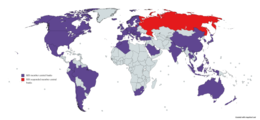
Back Bank für Internationalen Zahlungsausgleich ALS بنك التسويات الدولية Arabic Bancu de Pagos Internacionales AST Beynəlxalq hesablaşmalar bankı Azerbaijani Банк міжнародных разьлікаў BE-X-OLD Банка за международни разплащания Bulgarian Banc de Pagaments Internacionals Catalan Banka pro mezinárodní vypořádání Czech Bank for International Settlements Danish Bank für Internationalen Zahlungsausgleich German
 | |
 | |
 BIS members | |
| Established | 17 May 1930 |
|---|---|
| Type | International financial institution |
| Purpose | Central bank cooperation |
| Location |
|
| Coordinates | 47°32′53″N 7°35′31″E / 47.54806°N 7.59194°E |
Membership | Central banks from 63 jurisdictions |
| Agustín Carstens | |
Main organ | Board of directors[1] |
Staff | 1300 |
| Website | www |
The Bank for International Settlements (BIS) is an international financial institution which is owned by member central banks.[2] Its primary goal is to foster international monetary and financial cooperation while serving as a bank for central banks.[3] With its establishment in 1930 it is the oldest international financial institution.[4][5] Its initial purpose was to oversee the settlement of World War I war reparations.[5][6]
The BIS carries out its work through its meetings, programmes and through the Basel Process, hosting international groups pursuing global financial stability and facilitating their interaction. It also provides banking services, but only to central banks and other international organizations.
The BIS is based in Basel, Switzerland, with representative offices in Hong Kong and Mexico City.
- ^ "Board of Directors". www.bis.org/. Archived from the original on 22 April 2011. Retrieved 2011-04-14.
- ^ "About BIS". www.bis.org. 2005-01-01. Retrieved 2016-03-17.
- ^ "About BIS". Web page of Bank for International Settlements. January 2005. Archived from the original on 14 May 2008. Retrieved May 17, 2008.
- ^ "History - overview". www.bis.org. BIS. 1 June 2005. Retrieved 25 July 2024.
- ^ a b "History - foundation and crisis (1930-39)". www.bis.org. BIS. 14 October 2014. Retrieved 25 July 2024.
- ^ Clement, Piet (2023), Kakridis, Andreas; Eichengreen, Barry (eds.), "Institutionalizing Central Bank Cooperation: The Norman–Schacht Vision and Early Experience of the Bank for International Settlements, 1929–1933", The Spread of the Modern Central Bank and Global Cooperation: 1919–1939, Cambridge University Press, pp. 80–102, doi:10.1017/9781009367578.006, ISBN 978-1-009-36757-8